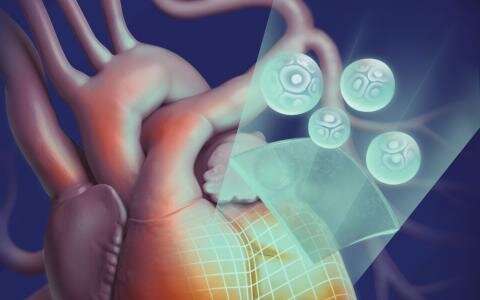This article has been reviewed according to Science X's editorial process and policies. Editors have highlighted the following attributes while ensuring the content's credibility:
fact-checked
trusted source
proofread
Bioengineered tissue from stem cells could help patients recover from damaging heart attacks

A new technology that uses bio-printed "patches" to repair damaged heart tissue has been proven to be safer and more cost-effective for patients than other patches.
Researchers from The University of Technology Sydney (UTS) have demonstrated that bio-engineered heart tissues can safely and effectively help patients recover from the damage caused by an extensive heart attack.
The findings have been published in the journal Bioprinting.
The new technology creates personalized "bio-inks" made of a patient's own stem cells. The "bio-inks" are then used to 3D-print cardiac tissues to repair areas of dead tissue caused by heart attacks.
"Thanks to our study we have a better understanding of how bioengineered heart tissues work in the body after their transplantation," said Dr. Carmine Gentile, head of the Cardiovascular Regeneration Group at UTS.
"Our study demonstrated that bio-engineered patches were the best and most robust treatment of heart failure—patches generated with other approaches either did not induce any improvement or the improvement was inconsistent.
"Our bio-engineered patches promise to be safer, more consistent and cost-effective for the patient."
Cardiovascular disease is the leading cause of death worldwide. In Australia, it accounts for about one in four deaths—claiming a life every 12 minutes.
Heart failure is a frequent complication of heart disease, with inadequate blood supply resulting in the death of heart tissue in an affected area. Life-long drug therapy may be required as a result, and end-stage heart failure means some patients join the waiting list for a heart transplant.
"Because this technology will enable patients to use their own stem cells to create the heart 'patches,' not only can they potentially dramatically reduce the trauma and cost of a heart transplant, but also avoid hurdles such as a body rejecting donor tissues," said Dr. Gentile.
Further testing for long term effects of this technology are underway before starting clinical trials.
"It's wonderful to hear that this research partnership has proven to be successful and is now able to progress to the next stage. We are excited about the potential of this technology to help the hundreds of thousands of people affected by heart failure each year," said Nicci Dent, CEO, Heart Research Australia.
More information: Christopher D. Roche et al, 3D bioprinted alginate-gelatin hydrogel patches containing cardiac spheroids recover heart function in a mouse model of myocardial infarction, Bioprinting (2023). DOI: 10.1016/j.bprint.2023.e00263




















